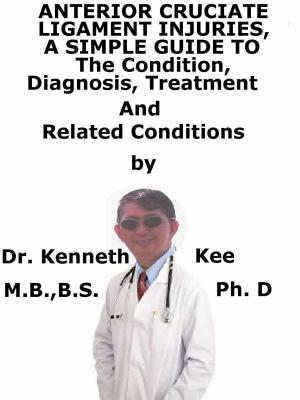Cubital Tunnel Syndrome, A Simple Guide To The Condition, Diagnosis, Treatment And Related Conditions
Nonfiction, Health & Well Being, Medical, Specialties, Orthopedics, Health, Ailments & Diseases, Nervous System & the Brain| Author: | Kenneth Kee | ISBN: | 9781370851805 |
| Publisher: | Kenneth Kee | Publication: | October 20, 2016 |
| Imprint: | Smashwords Edition | Language: | English |
| Author: | Kenneth Kee |
| ISBN: | 9781370851805 |
| Publisher: | Kenneth Kee |
| Publication: | October 20, 2016 |
| Imprint: | Smashwords Edition |
| Language: | English |
Cubital tunnel syndrome is believed to be the second most common compressive neuropathy.
The elbow is the most frequent location of compression of the ulnar nerve.
Cubital tunnel syndrome is present in men more often than women.
Symptoms are:
1. Wasting and weakness of the small muscles of the hand and partial clawing of the ring and little finger caused by ulnar nerve palsy.
2. The deformity and disability: extent of the disability is dependent on the site of the lesion.
3. Numbness and tingling along the little finger and ulnar half of the ring finger, often linked with a weakened grip, and particularly when the patient rests on or flexes the elbow.
4. Pain and tenderness at the level of the cubital tunnel.
5. Loss of grip and pinch strength and loss of fine dexterity in patients with chronic ulnar neuropathy.
6. Intrinsic muscle wasting and clawing or abduction of the little finger in severe prolonged compression
There is marked neurological abnormalities in prolonged severe ulnar nerve compression.
a. Claw hand
b. Wasting of the small muscles of the hand
3. Positive Tinel's sign
Treatment methods are:
1. Physiotherapy,
2. Splinting,
3. Non-steroidal anti-inflammatory or NSAID drugs,
4. Surgical transposition of the nerve
5. Surgical decompression for cubital tunnel syndrome.
TABLE OF CONTENT
Introduction
Chapter 1 Cubital Tunnel Syndrome
Chapter 2 Causes
Chapter 3 Symptoms
Chapter 4 Diagnosis
Chapter 5 Treatment
Chapter 6 Prognosis
Chapter 7 Carpal Tunnel Syndrome
Chapter 8 Trigger Finger
Epilogue
Cubital tunnel syndrome is believed to be the second most common compressive neuropathy.
The elbow is the most frequent location of compression of the ulnar nerve.
Cubital tunnel syndrome is present in men more often than women.
Symptoms are:
1. Wasting and weakness of the small muscles of the hand and partial clawing of the ring and little finger caused by ulnar nerve palsy.
2. The deformity and disability: extent of the disability is dependent on the site of the lesion.
3. Numbness and tingling along the little finger and ulnar half of the ring finger, often linked with a weakened grip, and particularly when the patient rests on or flexes the elbow.
4. Pain and tenderness at the level of the cubital tunnel.
5. Loss of grip and pinch strength and loss of fine dexterity in patients with chronic ulnar neuropathy.
6. Intrinsic muscle wasting and clawing or abduction of the little finger in severe prolonged compression
There is marked neurological abnormalities in prolonged severe ulnar nerve compression.
a. Claw hand
b. Wasting of the small muscles of the hand
3. Positive Tinel's sign
Treatment methods are:
1. Physiotherapy,
2. Splinting,
3. Non-steroidal anti-inflammatory or NSAID drugs,
4. Surgical transposition of the nerve
5. Surgical decompression for cubital tunnel syndrome.
TABLE OF CONTENT
Introduction
Chapter 1 Cubital Tunnel Syndrome
Chapter 2 Causes
Chapter 3 Symptoms
Chapter 4 Diagnosis
Chapter 5 Treatment
Chapter 6 Prognosis
Chapter 7 Carpal Tunnel Syndrome
Chapter 8 Trigger Finger
Epilogue















